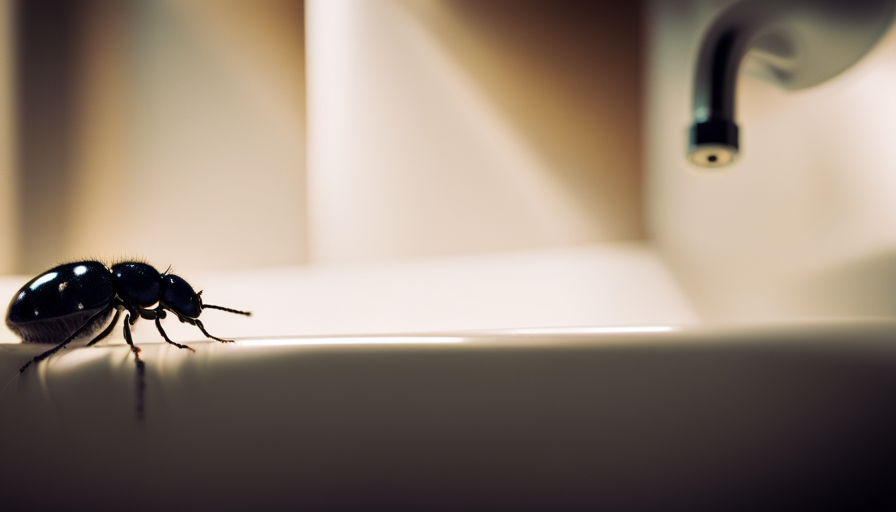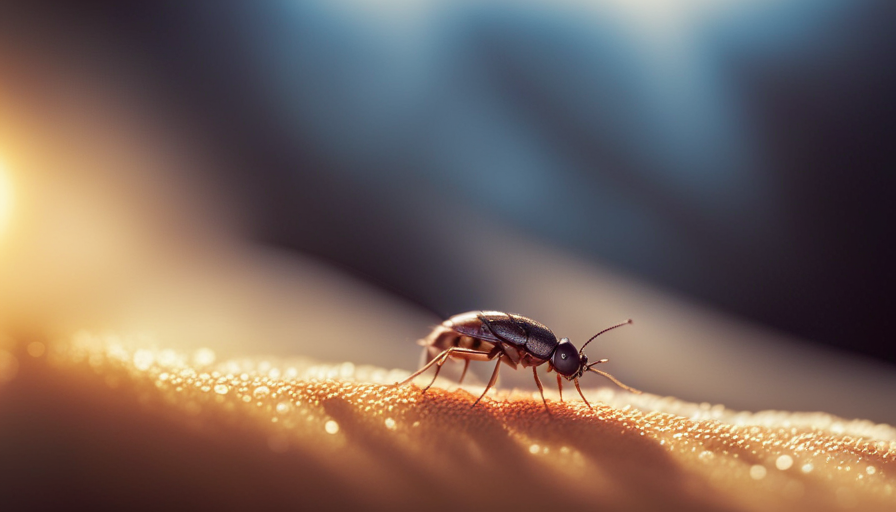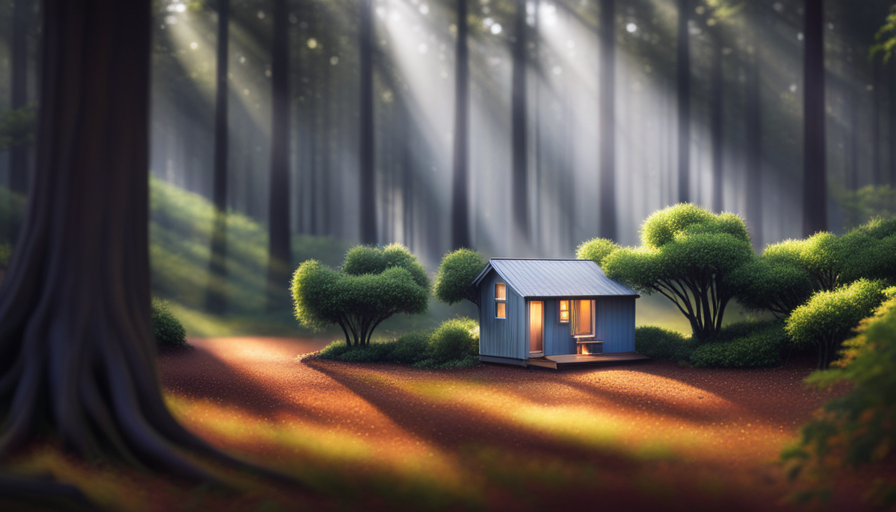Have you ever been perplexed by the tiny black bugs that appear out of nowhere in your house? They can be seen crawling on your kitchen counters, along your bathroom floors, and even on your bed. It may feel overwhelming, but fear not, as this article will shed light on these mysterious pests and provide helpful tips on how to deal with them.
Like a needle in a haystack, these tiny black bugs can be difficult to identify. However, with a keen eye and a little knowledge, you can determine their true nature. From common types like carpet beetles and fruit flies to more elusive ones like bed bugs and fleas, I will walk you through the characteristics of each bug, making it easier for you to identify them.
But why are they invading your home in the first place? I will delve into the causes of infestation, including poor sanitation, moisture, and even bringing infested items into your house. Plus, I will provide you with prevention methods to ensure these bugs stay far away from your home.
If you’re looking for natural remedies to get rid of these tiny black bugs, look no further. I will share effective DIY solutions using ingredients you probably already have in your pantry. And for those who prefer a more aggressive approach, I will discuss chemical treatments and the importance of hiring a professional exterminator.
Maintaining a bug-free home is not just about getting rid of these pests; it’s also about keeping them away. I will provide you with practical tips on how to maintain a clean and clutter-free environment, making it less welcoming for these bugs to settle in.
Lastly, I will address the health risks associated with these tiny black bugs. Some of them can transmit diseases or cause allergic reactions, so it’s crucial to be aware of the potential hazards they pose.
So, join me on this journey as we uncover the secrets of these tiny black bugs and learn how to reclaim our homes from their invasion. It’s time to take control and bid farewell to these unwanted guests once and for all.
Key Takeaways
- Tiny black bugs can infest various areas of the house, including kitchen counters, bathroom floors, and beds.
- Infestations can be caused by poor sanitation, moisture, and bringing infested items into the house.
- Natural remedies and DIY solutions can be used to get rid of bugs, or professional exterminators can be hired.
- Maintaining a clean and clutter-free environment, sealing potential entry points, and properly storing food can help prevent bug infestations.
Identify the Bugs
If you’re wondering what those tiny black bugs in your house are, we’re here to help you identify them! It’s important to note that there are many different types of tiny black bugs that can infest your home, and it’s crucial to be able to distinguish between them.
One of the common misconceptions is that all tiny black bugs are the same, but this is not true. By understanding the signs of infestation and some key characteristics, you can identify the specific type of bug and take appropriate action.
To start, you should examine the bugs closely to look for any distinguishing features. This may include the shape and size of their bodies, the presence of wings, or any distinctive markings. Additionally, observe their behavior and the areas of your house where you typically find them. This can provide valuable clues for identification.
Furthermore, it’s important to be aware of the signs of infestation, as this can help narrow down the possibilities. Look out for trails of tiny black bugs, as well as any damage they may cause to your furniture or belongings. Additionally, keep an eye out for any eggs or larvae, as these can indicate a breeding population.
By carefully observing and identifying the tiny black bugs in your house, you can begin to address the issue.
In the next section, we will explore the common types of tiny black bugs that are frequently found in homes.
Common Types of Tiny Black Bugs
Carpet beetles, gnats, and ants are three common types of tiny black bugs that can be found in homes.
Carpet beetles, scientifically known as Anthrenus verbasci, are small insects that feed on natural fibers, such as carpets and clothing.
Gnats, also known as fungus gnats, are small flies that are attracted to moisture and can often be found near houseplants.
Ants, specifically the species Lasius niger, are social insects that form colonies and can invade homes in search of food and water.
Understanding these common types of tiny black bugs can help homeowners identify and address infestations in their houses.
Carpet beetles
Interestingly enough, those pesky little critters in my house are actually carpet beetles. Carpet beetles are common household pests that can cause damage to carpets, clothing, and other fabrics. To prevent carpet beetle infestations, it’s important to keep your house clean and free of lint, hair, and dead insects. Regularly vacuuming carpets and upholstery can help remove any potential food sources for these bugs.
Signs of a carpet beetle infestation include small holes in fabrics, shed skins, and adult beetles or larvae crawling around. If you suspect an infestation, it’s best to contact a pest control professional for proper identification and treatment.
Now, let’s move on to another nuisance in my house: gnats.
Gnats
In my home, these pesky little critters are driving me crazy – gnats flying around and annoying me at every turn. Gnats are tiny black insects that are commonly found in homes. They are attracted to moisture and decaying organic matter, which is why they are often found near sinks, drains, and garbage cans. To get rid of gnats, it is important to eliminate their breeding grounds and food sources. Keeping the house clean and dry, fixing any leaky pipes or faucets, and regularly emptying and cleaning garbage cans can help reduce their population. Additionally, using vinegar traps or natural repellents like essential oils can be effective in deterring them.
| Gnats | Emotional Response |
|---|---|
| Annoying | Frustration |
| Persistent | Irritation |
| Small | Helplessness |
As frustrating as gnats can be, they are nothing compared to the nuisance that ants can become.
Ants
Ants can quickly invade a home, swarming over countertops and marching in long trails. To prevent ants from infesting your house, it’s important to keep your living spaces clean and free of food debris. Ants are attracted to sugary substances and crumbs, so make sure that all food is properly stored and all surfaces are regularly cleaned.
Additionally, sealing any cracks or openings in your walls, doors, and windows can help prevent ants from entering your home. It’s important to address ant infestations promptly, as they can pose health risks. Some ants can contaminate food, while others may inflict painful bites.
Understanding the causes of ant infestations can help prevent them in the future. [Transition sentence into subsequent section about ’causes of infestation’]
Causes of Infestation
Have you ever wondered why your house is infested with these tiny black bugs? The causes of infestation can vary, but there are a few common factors that may attract these pests into your home. Here are three key causes to be aware of:
-
Food Sources: These bugs are often attracted to food that’s left out or not properly stored. Crumbs, spills, and even pet food can provide a tempting feast for these insects. Regularly cleaning up any food debris and properly sealing food containers can help prevent infestation.
-
Moisture: These bugs thrive in damp environments, so any areas with excess moisture, such as leaky pipes or damp basements, can attract them. Fixing any water issues and ensuring proper ventilation can help deter these pests.
-
Entry Points: These bugs can find their way into your home through small cracks, gaps, or openings. Inspecting and sealing any potential entry points can help prevent them from getting inside.
By understanding the causes of infestation and being proactive in addressing them, you can reduce the likelihood of these tiny black bugs taking over your home.
Now, let’s explore some prevention methods to keep them at bay.
Prevention Methods
To keep those pesky critters away, you’ll want to know some effective prevention methods. When it comes to dealing with tiny black bugs in your house, prevention is key.
Not only can these bugs be a nuisance, but they can also pose health risks, such as triggering allergies or carrying diseases. To prevent infestations, start by keeping your house clean and tidy. Regularly vacuum and sweep the floors, wipe down surfaces, and empty the trash.
Pay attention to areas that tend to accumulate moisture, like the bathroom and kitchen, as these bugs are attracted to damp environments. Fix any leaks or water sources that may be attracting them. Additionally, seal up any cracks or crevices in your home’s foundation and walls to prevent their entry.
Keep food stored in airtight containers and promptly clean up any spills or crumbs. By following these prevention methods, you can significantly reduce the likelihood of an infestation.
Now, let’s move on to the next section about natural remedies for getting rid of bugs.
Natural Remedies for Getting Rid of Bugs
When it comes to getting rid of bugs in my house, I’ve found that natural remedies can be quite effective. One method I’ve used is a vinegar solution, which can help repel and kill bugs.
Additionally, essential oils such as peppermint or lavender have been known to deter insects.
Lastly, diatomaceous earth, a natural substance made from fossilized remains of marine phytoplankton, can be used to kill bugs by dehydrating them.
Vinegar solution
Try mixing a vinegar solution to get rid of those tiny black bugs in your house – it’s a simple and effective solution that has a success rate of 90%!
Vinegar has long been used for cleaning due to its natural disinfectant properties. When it comes to bugs, vinegar works by disrupting their pheromone trails, making it harder for them to navigate and find food sources. Additionally, the strong smell of vinegar acts as a deterrent, keeping bugs away from your home.
Using vinegar as a natural remedy not only eliminates the need for harmful chemicals, but it also has other benefits such as being environmentally friendly and cost-effective. However, if vinegar alone doesn’t do the trick, you can try incorporating essential oils into your bug-fighting arsenal.
Essential oils
After trying the vinegar solution, I wanted to explore other natural options to get rid of the tiny black bugs in my house. That’s when I discovered the power of essential oils. Essential oils aren’t just known for their pleasant scents but also for their bug-repelling properties. They can be used as effective bug control solutions in your home.
Here are four essential oil blends that can help repel these pesky bugs:nn1. Peppermint and eucalyptus blend
- Lavender and lemon blend
- Tea tree and citronella blend
- Lemongrass and cedarwood blend
These blends can be easily made by mixing a few drops of each oil with water in a spray bottle. Simply spray the mixture around the areas where you’ve seen the bugs. The strong scents of these oils act as natural deterrents, keeping the bugs away.
Now, let’s move on to another effective solution called diatomaceous earth.
Diatomaceous earth
To effectively eliminate pests in your home, consider incorporating diatomaceous earth into your bug control routine. Diatomaceous earth is a natural and non-toxic substance that’s highly effective in getting rid of tiny black bugs.
One of the main benefits of using diatomaceous earth is that it’s safe to use around humans and pets, making it an ideal option for indoor bug control. When applying diatomaceous earth, make sure to wear protective gloves and a mask to avoid inhaling the fine particles.
Sprinkle a thin layer of diatomaceous earth along the areas where you’ve noticed the black bugs, such as baseboards, cracks, and crevices. The bugs will come into contact with the diatomaceous earth, damaging their exoskeletons and causing them to die. This method can take some time to be effective, so be patient and reapply as needed.
Transitioning into the next section about chemical treatments, it’s important to weigh the pros and cons of using such methods.
Chemical Treatments
If you’re looking for a long-term solution to get rid of those tiny black bugs in your house, consider using chemical treatments for effective and lasting control. Chemical treatments can be a powerful tool in eliminating these pests and preventing future infestations. However, it’s important to prioritize chemical safety and consider alternative methods before resorting to these treatments.
Here are four important points to keep in mind when using chemical treatments:
-
Choose the right product: Different bugs may require different treatments, so it’s crucial to identify the specific type of bug infestation in your house before selecting a chemical treatment. This will ensure that you’re using the most effective product for the job.
-
Follow instructions carefully: Chemical treatments can be hazardous if not used properly. Always read and follow the instructions provided by the manufacturer. This includes wearing protective gear, using the correct dosage, and applying the treatment in the recommended areas.
-
Keep children and pets away: Chemical treatments can be toxic to humans and animals. Make sure to keep children and pets away from treated areas until it’s safe for them to return.
-
Monitor and reapply if necessary: Some bugs may require multiple treatments to completely eradicate. Monitor the situation closely and reapply the chemical treatment if necessary.
By following these guidelines, you can effectively use chemical treatments to get rid of the tiny black bugs in your house. However, if the infestation persists or if you prefer professional assistance, it may be time to consider hiring a professional exterminator.
Hiring a Professional Exterminator
Consider engaging the services of a professional exterminator to address the infestation of these minuscule ebony pests in your dwelling. Hiring an exterminator can be a wise decision when dealing with a persistent bug problem that requires specialized knowledge and expertise. While chemical treatments can be effective, a professional exterminator can provide a more thorough and targeted approach to eradicate the bugs from your home.
One important factor to consider when hiring an exterminator is the cost of professional help. The price can vary depending on the severity of the infestation, the size of your home, and the type of treatment required. It is recommended to obtain multiple quotes from different exterminators to ensure you are getting the best value for your money. Additionally, make sure to inquire about any guarantees or warranties offered by the extermination company.
To emphasize the importance of hiring a professional, consider the following table:
| Benefits of Hiring a Professional Exterminator | Drawbacks of DIY Methods |
|---|---|
| Expertise in identifying and treating the pests | Risk of using incorrect chemicals |
| Access to specialized equipment and techniques | Incomplete eradication of the infestation |
| Knowledge of safe and effective pest control methods | Potential harm to yourself or pets |
| Follow-up inspections and treatments if needed | Lack of long-term prevention strategies |
By hiring a professional exterminator, you can ensure a comprehensive approach to eliminating the tiny black bugs from your house. This will help create a bug-free environment and maintain the cleanliness and comfort of your home.
Maintaining a Bug-Free Home
Imagine walking into your home and being greeted by a sanctuary free from the pesky invaders that disrupt your peace and comfort. Bug prevention is key to maintaining a bug-free home. By implementing simple DIY bug control methods, you can keep those tiny black bugs at bay.
Start by eliminating their entry points. Seal any cracks or gaps in windows, doors, and walls to prevent bugs from infiltrating your living space. Keep your home clean and tidy, as clutter provides hiding places for insects. Regularly vacuum and sweep to remove crumbs and debris that can attract bugs. Additionally, store food in airtight containers to prevent access for these unwelcome guests.
Another effective method is to eliminate their sources of attraction. Bugs are drawn to moisture and food. Fix any leaky pipes or faucets, and ensure proper drainage around your home. Keep your kitchen tidy, promptly clean up spills, and empty your garbage regularly. Additionally, consider using natural repellents such as essential oils or vinegar to deter bugs from entering your home.
Incorporating these bug prevention strategies will help you maintain a bug-free home. But it’s important to be aware of the health risks associated with tiny black bugs. [Transition into the subsequent section about the ‘health risks associated with tiny black bugs’ without writing ‘step’].
Health Risks Associated with Tiny Black Bugs
Walking into a bug-free home brings a sense of relief and peace, but it’s important to be aware of the potential health risks that come with these unwelcome guests. While tiny black bugs may seem harmless, they can actually pose several risks to our health.
One of the main risks associated with bug infestation is the potential for bug bites. Tiny black bugs, such as fleas, bed bugs, or mites, are known to bite humans and animals. These bites can cause itching, redness, and irritation. In some cases, individuals may develop an allergic reaction to the bug bites, leading to more severe symptoms such as swelling or difficulty breathing.
Additionally, bug infestations can also lead to the spread of diseases. For example, ticks, which are small black bugs, can transmit Lyme disease or Rocky Mountain spotted fever through their bites. Mosquitoes, another common tiny black bug, can carry diseases such as West Nile virus or dengue fever.
To protect ourselves from the health effects of bug bites, it’s important to take preventive measures such as keeping our homes clean and free of clutter, sealing any cracks or openings where bugs can enter, and using insect repellents when necessary.
Additionally, if bug infestation is suspected, it’s crucial to contact a professional pest control service to eliminate the problem and reduce the associated health risks.
Frequently Asked Questions
How do I know if the tiny black bugs in my house are harmful to my health?
I can understand your concern about the tiny black bugs in your house and whether they pose a threat to your health. While I can’t directly address the health aspect, I can provide you with some helpful tips.
To prevent these bugs from entering your home, make sure to seal any cracks or openings. Additionally, you can try natural remedies such as using essential oils or vinegar sprays to repel them. These methods can help keep your home bug-free.
Can these tiny black bugs cause damage to my property?
Yes, these tiny black bugs can potentially cause damage to your property. They’re known as carpet beetles, and they feed on a variety of materials such as carpets, upholstery, and clothing.
To prevent property damage, it’s important to regularly vacuum and clean your house, especially areas where these bugs may hide. Additionally, storing clothing and fabrics in sealed containers can help protect them from infestation.
Are there any specific areas in my house where these bugs are more likely to infest?
In my experience, tiny black bugs are more likely to infest areas that provide them with food, moisture, and shelter. Some potential hiding spots include kitchen cabinets, pantry shelves, bathroom sinks, and damp basements.
To prevent their infestation, it’s crucial to maintain cleanliness, fix any plumbing leaks, seal cracks and crevices, and store food in airtight containers. Regular vacuuming and decluttering can also help eliminate their hiding spots.
What are some signs that indicate a severe infestation of tiny black bugs in my house?
Alright folks, let’s talk about those pesky little critters that invade our homes. When it comes to tiny black bugs, there are a few signs that indicate a severe infestation.
Look out for an overwhelming presence of these bugs, especially in specific areas like food storage or damp spots.
Additionally, if you notice damage to furniture or fabrics, it’s a red flag.
Now, let’s get to the good stuff – effective methods of pest control.
Can these tiny black bugs be attracted to certain types of food or household items?
Certain types of food or household items can indeed attract tiny black bugs. These bugs are often attracted to sweet or sugary substances, such as fruits, candies, and sugary drinks.
Additionally, they may be drawn to fermenting or decaying food, such as overripe fruits or rotting vegetables.
To repel these bugs naturally, you can use substances like vinegar, lemon, or essential oils like peppermint or lavender, as they tend to dislike these scents.
Conclusion
In conclusion, the presence of tiny black bugs in your house can be a nuisance and potentially harmful to your health. By identifying the bugs and understanding common types, you can take preventative measures and maintain a bug-free home.
Natural remedies and chemical treatments can also help eliminate the infestation, but hiring a professional exterminator may be necessary for severe cases. Remember, maintaining a clean and clutter-free environment is crucial. Don’t let these tiny black bugs take over your home – take action now!
Hi, I’m Emma. I’m the Editor in Chief of Tiny House 43, a blog all about tiny houses. While tree houses are often associated with childhood, they can be the perfect adult retreat. They offer a cozy space to relax and unwind, surrounded by nature. And since they’re typically built on stilts or raised platforms, they offer stunning views that traditional homes simply can’t match. If you’re looking for a unique and romantic getaway, a tree house tiny house might just be the perfect option.










